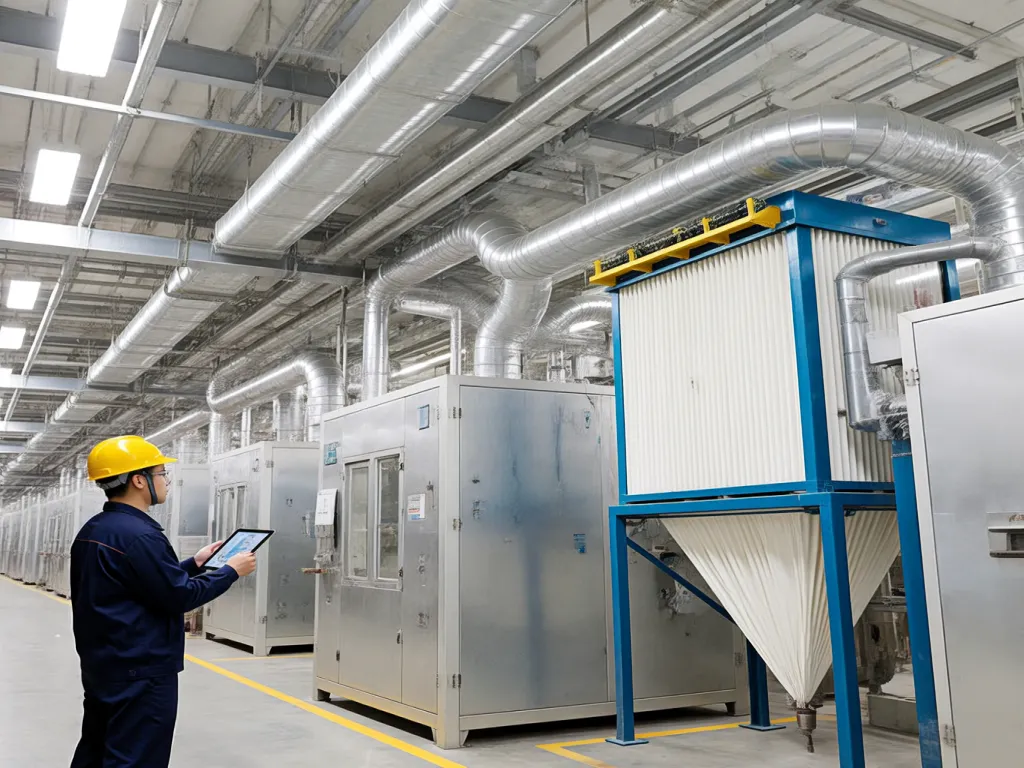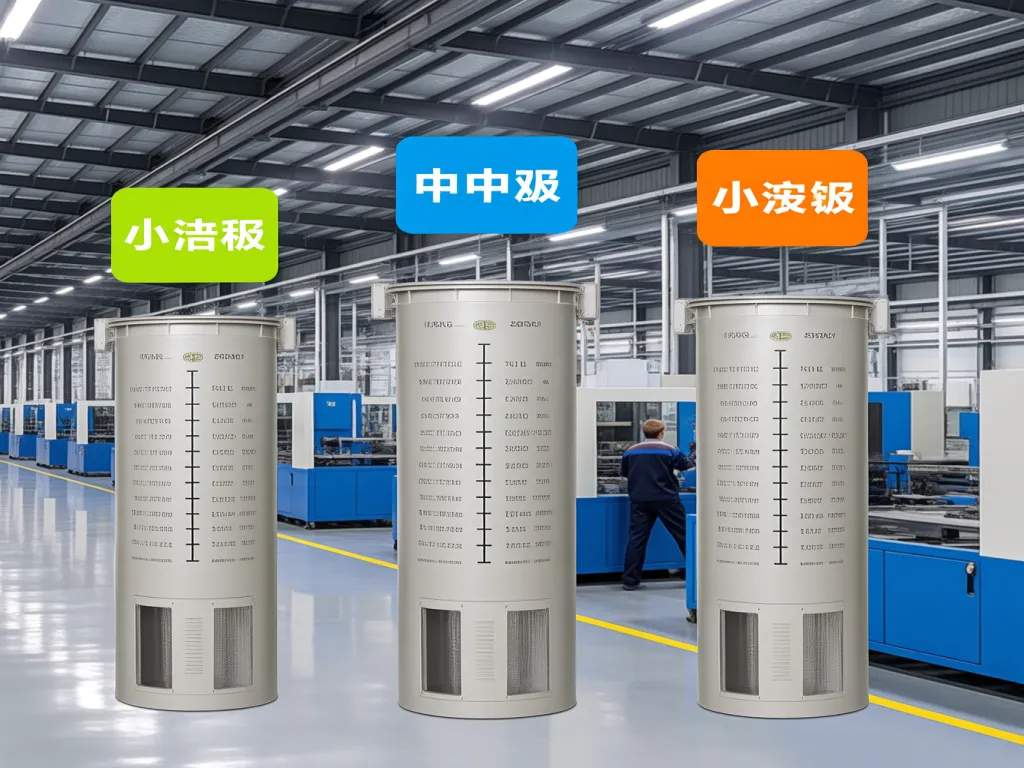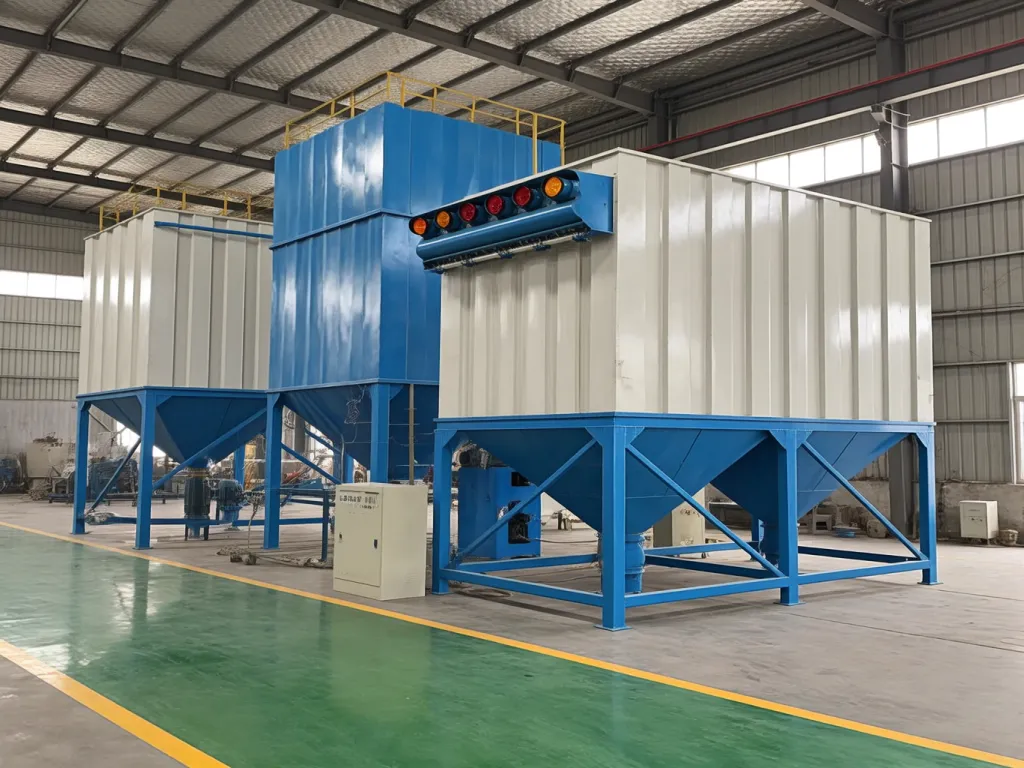Factory Scale Guide: Picking Your Bag Filter Dust Collector

Navigating the world of industrial filtration can be overwhelming, especially when you’re trying to match a bag filter dust collector to your factory’s unique needs. Whether you’re running a compact operation or managing a sprawling industrial complex, the right choice in dust collection technology is crucial for both efficiency and environmental compliance. But how do you ensure you’re picking the perfect fit? This guide dives deep into the art of selecting a bag filter dust collector tailored to your factory’s scale, ensuring you breathe easy with every decision.

Matching Factory Scale with Bag Filter Dust Collector Capacity: A Detailed Analysis
When it comes to industrial filtration, the one-size-fits-all approach simply doesn’t work. As a factory owner or production manager, you’re intimately familiar with the unique challenges your operation faces. That’s why understanding how factory scale directly impacts your bag filter dust collector requirements is so crucial. Let’s break down exactly what different-sized operations need to consider.
Small-scale factories (typically employing fewer than 50 workers or occupying less than 5,000 square feet) often operate with simpler production processes. But don’t let their size fool you – even small operations can generate significant dust and particulate matter. For these environments, a compact bag filter dust collector with treatment capacities ranging from 1,000 to 5,000 CFM (cubic feet per minute) usually hits the sweet spot. The key here is finding a balance between adequate filtration and minimal footprint. Many small factories we work with appreciate models that combine efficient dust collection with easy installation and maintenance. After all, every square foot counts when you’re working with limited space.
Moving up to medium-scale factories (50-200 employees or 5,000-20,000 square feet), the requirements become more complex. These operations typically involve multiple production lines or processes generating different types of dust simultaneously. Here, you’ll want a bag filter dust collector capable of handling 5,000 to 20,000 CFM. But capacity isn’t the only factor – medium factories often need modular systems that can adapt as production scales up. We frequently see medium-sized operations benefit from pulse-jet cleaning systems that maintain consistent airflow while reducing maintenance downtime. Have you considered how your current system handles varying dust loads throughout the day?
Large-scale factories (over 200 employees or more than 20,000 square feet) face the most demanding filtration challenges. These operations might include multiple buildings, 24/7 production schedules, and complex dust generation profiles. For large factories, we typically recommend bag filter dust collectors with capacities exceeding 20,000 CFM, often with multiple units working in tandem. But it’s not just about raw capacity – large operations need sophisticated control systems, energy recovery options, and often compliance with strict environmental regulations. Some of our largest clients have found significant cost savings by implementing smart filtration systems that adjust automatically to production demands. How does your current system measure up to these advanced requirements?
Small Factory Considerations
For small factories, the priority often lies in finding compact yet effective solutions. Many small operations we’ve worked with initially underestimate their dust collection needs, only to discover later that inadequate filtration is causing equipment wear, product quality issues, or even regulatory non-compliance. A good rule of thumb? Look for systems that offer at least 20% more capacity than your current maximum dust generation. This provides headroom for production increases and helps maintain consistent performance. Consider reviewing guidelines from authoritative sources like the EPA on industrial dust control for additional insights.
Medium Factory Challenges
Medium-sized factories frequently grapple with balancing immediate needs against future growth. We often recommend modular systems that allow for easy expansion. These factories also benefit from advanced filtration media that can handle multiple dust types without frequent replacement. Have you considered how your dust characteristics might change as you introduce new products or processes? Choosing a versatile system now can save significant costs down the road.
Large Factory Complexities
Large factories require comprehensive dust collection strategies that go beyond individual machines. These operations often need centralized filtration systems with sophisticated monitoring and control capabilities. Some of our largest clients have implemented real-time dust load sensors that automatically adjust cleaning cycles, reducing energy consumption by up to 30%. For large operations, the total cost of ownership becomes particularly important – initial purchase price is just one piece of the puzzle.

Selecting the Right Bag Filter Dust Collector for Your Factory Scale
When it comes to choosing a bag filter dust collector, the size of your factory plays a pivotal role. It’s not just about finding a device that fits your budget; it’s about matching the equipment’s capabilities to your specific production needs. Let’s dive into the nitty-gritty of selecting the perfect bag filter dust collector based on your factory’s scale, focusing on key aspects like air volume handling, filtration efficiency, and space requirements.
First off, let’s talk about air volume handling. This is essentially how much air the dust collector can process per unit time, usually measured in cubic feet per minute (CFM) or cubic meters per hour (m³/h). For small factories, where production volumes are relatively low, a compact bag filter dust collector with a moderate air volume capacity might suffice. These units are designed to handle the dust generated by a few machines or a small production line, ensuring that the air stays clean without overburdening the system.
Moving up to medium-sized factories, the scenario changes. Here, production lines are more extensive, and the volume of dust generated increases significantly. You’ll need a bag filter dust collector with a higher air volume capacity to keep up with the demand. This means looking for models that can handle several thousand CFM or m³/h, ensuring that all dust is captured efficiently, even during peak production hours.
For large factories, the stakes are even higher. These facilities often operate multiple production lines simultaneously, generating vast amounts of dust. In such cases, a single, high-capacity bag filter dust collector might not be enough. Instead, you might consider a system of interconnected collectors or a large, centralized unit designed to handle extremely high air volumes. The key here is scalability – the ability to expand the system as your production needs grow.
Now, let’s talk about filtration efficiency. This is a critical factor, regardless of your factory’s size. The goal is to capture as much dust as possible, ensuring that the air released back into the environment is clean and safe. For small factories, a basic bag filter dust collector with a decent filtration efficiency might be adequate. However, as you move up to medium and large factories, you’ll want to look for models with higher filtration efficiencies, often expressed as a percentage of particles captured. Aim for collectors that can filter out at least 99% of dust particles, ensuring compliance with environmental regulations such as those outlined by the EPA and protecting your workers’ health.
Space is another crucial consideration. In small factories, where every square foot counts, you’ll want a compact, space-saving bag filter dust collector. These units are designed to fit into tight spaces without compromising on performance. For medium and large factories, while space might be less of a constraint, you still need to consider the layout and accessibility of the dust collector. Look for models that can be easily integrated into your existing production setup, with minimal disruption to your workflow.
So, how do you know which bag filter dust collector is right for your factory? Start by assessing your production needs – how much dust are you generating, and what are your air volume requirements? Then, consider your space constraints and filtration efficiency goals. Don’t be afraid to reach out to manufacturers or suppliers for advice; they can provide valuable insights based on your specific situation.
Remember, choosing the right bag filter dust collector isn’t just about compliance; it’s about optimizing your production process, protecting your workers, and ensuring a sustainable future for your business. Take the time to research and select a unit that meets your needs today and can grow with you tomorrow.
Air Volume Handling Across Factory Scales
For small factories, a compact bag filter dust collector with a moderate air volume capacity is ideal. These units are designed to handle the dust generated by a few machines or a small production line. As you move to medium-sized factories, production volumes increase, requiring a bag filter dust collector with a higher air volume capacity. Large factories, with multiple production lines, might need a system of interconnected collectors or a large, centralized unit to handle the vast amounts of dust generated.
Filtration Efficiency: A Universal Concern
Regardless of factory size, filtration efficiency is paramount. Small factories might get by with a basic model, but medium and large factories should aim for collectors with at least 99% filtration efficiency. This ensures compliance with environmental regulations and protects workers’ health by capturing as much dust as possible.
Space Considerations: Compact vs. Expansive
In small factories, space is at a premium, so a compact, space-saving bag filter dust collector is essential. For medium and large factories, while space might be less of an issue, the layout and accessibility of the dust collector are still important. Look for models that can be easily integrated into your production setup with minimal disruption.

Real-World Success Stories: Matching Bag Filter Dust Collectors to Factory Scale
Choosing the right bag filter dust collector for your factory isn’t just about specs and numbers—it’s about seeing real results. Let’s dive into three case studies where factories of different sizes picked the perfect dust collector and watched their production soar.
Case Study 1: Small-Scale Precision Manufacturing
Meet ‘Precision Parts Inc.’, a small-scale shop specializing in intricate metal components. Their workspace? A compact 2,000 sq ft area buzzing with CNC machines. The challenge? Managing fine metal dust that threatened both worker health and machine precision.
Initially, they tried a basic, off-the-shelf dust collector. But it struggled with the fine particles, leading to frequent maintenance and inconsistent air quality. The turning point? Switching to a compact bag filter dust collector designed specifically for small spaces and fine dust.
Key features they prioritized:
- Compact Design: Fits snugly in their limited space without compromising performance.
- High-Efficiency Filtration: Captures even the tiniest metal particles, ensuring clean air.
- Easy Maintenance: Quick-change filter bags meant less downtime and more uptime.
The result? A 30% reduction in airborne dust, leading to fewer health issues among workers and a noticeable improvement in product quality. Plus, the lower maintenance needs freed up staff to focus on production.
Case Study 2: Mid-Sized Chemical Processing Plant
Now, let’s visit ‘ChemCo Solutions’, a mid-sized plant processing chemicals for various industries. Their operation spans 10,000 sq ft, with multiple processing lines generating a mix of dust and fumes.
Their old dust collector was a behemoth, taking up too much space and consuming excessive energy. It also couldn’t handle the diverse range of particulates, leading to frequent clogs and inefficiencies.
The solution? A modular bag filter dust collector system. Here’s why it worked:
- Modular Design: Allowed them to customize the setup based on different processing zones.
- Variable Speed Control: Adjusted airflow according to the specific needs of each line, saving energy.
- Durable Construction: Withstood the corrosive nature of chemical dust, ensuring longevity.
Post-installation, ChemCo saw a 25% drop in energy costs and a significant improvement in air quality. The modular system also made it easier to expand as their production grew.
Case Study 3: Large-Scale Cement Production Facility
Finally, let’s explore ‘CementWorks Global’, a large-scale cement plant covering 50,000 sq ft. Their primary concern? Managing massive volumes of cement dust generated during grinding and packing.
Their previous system was outdated, struggling to keep up with the high dust loads. It led to frequent breakdowns, high maintenance costs, and even compliance issues with environmental regulations.
The game-changer? A high-capacity, pulse-jet bag filter dust collector. Key attributes that made the difference:
- High Airflow Capacity: Handled the enormous dust volumes without a hitch.
- Pulse-Jet Cleaning: Automatically cleaned filters, reducing manual intervention and downtime.
- Robust Construction: Built to withstand the harsh conditions of a cement plant.
The impact was profound. CementWorks reported a 40% reduction in dust emissions, meeting stringent environmental standards. Maintenance costs plummeted by 35%, and overall production efficiency jumped by 20%.
Why These Cases Matter
Each of these stories highlights a crucial point: there’s no one-size-fits-all when it comes to bag filter dust collectors. Small factories need compact, efficient solutions; mid-sized ones benefit from modularity and adaptability; while large-scale operations demand high capacity and durability.
So, how do you ensure you’re making the right choice? Start by assessing your factory’s specific needs—dust type, volume, space constraints, and budget. Then, look for a dust collector that ticks all those boxes, just like these successful factories did.
Remember, the right bag filter dust collector isn’t just an expense—it’s an investment in your workers’ health, your product quality, and your bottom line. By choosing wisely, you’re setting your factory up for long-term success and sustainability.
Small-Scale Precision Manufacturing: A Compact Solution
For small factories like ‘Precision Parts Inc.’, space is at a premium. They needed a dust collector that could fit into their compact workspace without sacrificing performance. It not only saved space but also delivered high-efficiency filtration, capturing even the finest metal particles. The easy maintenance feature was a bonus, reducing downtime and keeping production running smoothly.
Mid-Sized Chemical Processing: Modularity and Adaptability
‘ChemCo Solutions’ faced a unique challenge with their diverse range of processing lines. A one-size-fits-all approach wouldn’t work. They needed a modular system that could adapt to different zones. The modular bag filter dust collector provided just that. With variable speed control, they could adjust airflow based on specific needs, saving energy. The durable construction ensured it could withstand the corrosive nature of chemical dust, making it a long-term investment.
Large-Scale Cement Production: High Capacity and Durability
For ‘CementWorks Global’, the primary concern was managing massive volumes of cement dust. Their outdated system couldn’t keep up, leading to frequent breakdowns and high maintenance costs. The high-capacity, pulse-jet bag filter dust collector was the solution. It handled the enormous dust loads effortlessly, with pulse-jet cleaning reducing manual intervention. The robust construction ensured it could withstand the harsh conditions, making it a reliable choice for large-scale operations.
Selecting the ideal bag filter dust collector for your factory isn’t just about ticking boxes—it’s about enhancing productivity, safeguarding your workforce, and upholding environmental standards. By considering your factory’s scale, processing demands, and spatial constraints, you can pinpoint the dust removal equipment that not only fits but flourishes in your industrial setting. Remember, the right choice today means smoother operations tomorrow. So, why wait? Dive into our guide, leverage the insights, and empower your factory with a bag filter dust collector that’s just right. Ready to transform your industrial space? Let’s get started!
